Related Research Articles

The tibia, also known as the shinbone or shankbone, is the larger, stronger, and anterior (frontal) of the two bones in the leg below the knee in vertebrates ; it connects the knee with the ankle. The tibia is found on the medial side of the leg next to the fibula and closer to the median plane. The tibia is connected to the fibula by the interosseous membrane of leg, forming a type of fibrous joint called a syndesmosis with very little movement. The tibia is named for the flute tibia. It is the second largest bone in the human body, after the femur. The leg bones are the strongest long bones as they support the rest of the body.
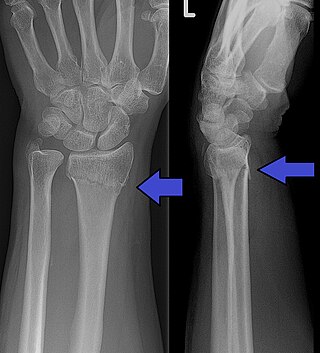
A Colles' fracture is a type of fracture of the distal forearm in which the broken end of the radius is bent backwards. Symptoms may include pain, swelling, deformity, and bruising. Complications may include damage to the median nerve.

A bone fracture is a medical condition in which there is a partial or complete break in the continuity of any bone in the body. In more severe cases, the bone may be broken into several fragments, known as a comminuted fracture. A bone fracture may be the result of high force impact or stress, or a minimal trauma injury as a result of certain medical conditions that weaken the bones, such as osteoporosis, osteopenia, bone cancer, or osteogenesis imperfecta, where the fracture is then properly termed a pathologic fracture.

A cervical fracture, commonly called a broken neck, is a fracture of any of the seven cervical vertebrae in the neck. Examples of common causes in humans are traffic collisions and diving into shallow water. Abnormal movement of neck bones or pieces of bone can cause a spinal cord injury, resulting in loss of sensation, paralysis, or usually death soon thereafter, primarily via compromising neurological supply to the respiratory muscles as well as innervation to the heart.

A Jones fracture is a broken bone in a specific part of the fifth metatarsal of the foot between the base and middle part that is known for its high rate of delayed healing or nonunion. It results in pain near the midportion of the foot on the outside. There may also be bruising and difficulty walking. Onset is generally sudden.

A Smith's fracture, is a fracture of the distal radius.
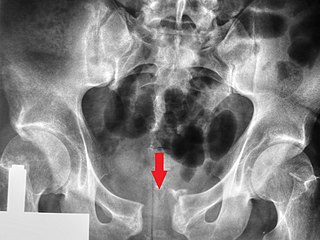
A pelvic fracture is a break of the bony structure of the pelvis. This includes any break of the sacrum, hip bones, or tailbone. Symptoms include pain, particularly with movement. Complications may include internal bleeding, injury to the bladder, or vaginal trauma.

Cataclasite is a cohesive granular fault rock. Comminution, also known as cataclasis, is an important process in forming cataclasites. They fall into the category of cataclastic rocks which are formed through faulting or fracturing in the upper crust. Cataclasites are distinguished from fault gouge, which is incohesive, and fault breccia, which contains coarser fragments.

An open fracture, also called a compound fracture, is a type of bone fracture that has an open wound in the skin near the fractured bone. The skin wound is usually caused by the bone breaking through the surface of the skin. Open fractures are emergencies and are often caused by high energy trauma such as road traffic accidents and are associated with a high degree of damage to the bone and nearby soft tissue. An open fracture can be life threatening or limb-threatening due to the risk of a deep infection and/or bleeding. Other complications including a risk of malunion of the bone or nonunion of the bone. The severity of open fractures can vary. For diagnosing and classifying open fractures, Gustilo-Anderson open fracture classification is the most commonly used method. It can also be used to guide treatment, and to predict clinical outcomes. Advanced trauma life support is the first line of action in dealing with open fractures and to rule out other life-threatening condition in cases of trauma. The person is also administered antibiotics for at least 24 hours to reduce the risk of an infection. Cephalosporins are generally the first line of antibiotics. Therapeutic irrigation, wound debridement, early wound closure and bone fixation are the main management of open fractures. All these actions aimed to reduce the risk of infections. The bone that is most commonly injured is the tibia and working-age young men are the group of people who are at highest risk of an open fracture. Older people with osteoporosis and soft-tissue problems are also at risk.
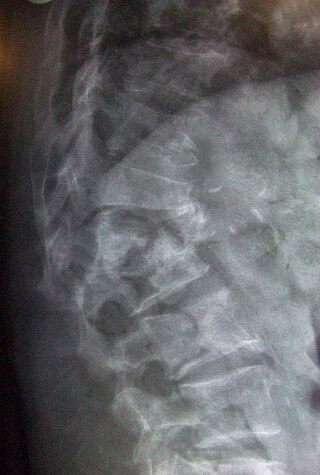
A spinal fracture, also called a vertebral fracture or a broken back, is a fracture affecting the vertebrae of the spinal column. Most types of spinal fracture confer a significant risk of spinal cord injury. After the immediate trauma, there is a risk of spinal cord injury if the fracture is unstable, that is, likely to change alignment without internal or external fixation.

A tibial plateau fracture is a break of the upper part of the tibia (shinbone) that involves the knee joint. Symptoms include pain, swelling, and a decreased ability to move the knee. People are generally unable to walk. Complication may include injury to the artery or nerve, arthritis, and compartment syndrome.

Meteorite shock stage is a measure of the degree of fracturing of the matrix of a common chondrite meteorite. Impacts on the parent body of a meteoroid can produce very large pressures. These pressures heat, melt and deform the rocks. This is called shock metamorphism. Meteorites are often given a rating from 1 to 6 showing the level of shock metamorphism. However, the degree of shock can vary within a meteorite on the scale of centimeters.
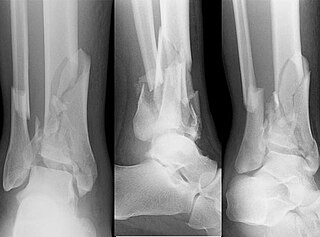
A pilon fracture, is a fracture of the distal part of the tibia, involving its articular surface at the ankle joint. Pilon fractures are caused by rotational or axial forces, mostly as a result of falls from a height or motor vehicle accidents. Pilon fractures are rare, comprising 3 to 10 percent of all fractures of the tibia and 1 percent of all lower extremity fractures, but they involve a large part of the weight-bearing surface of the tibia in the ankle joint. Because of this, they may be difficult to fixate and are historically associated with high rates of complications and poor outcome.
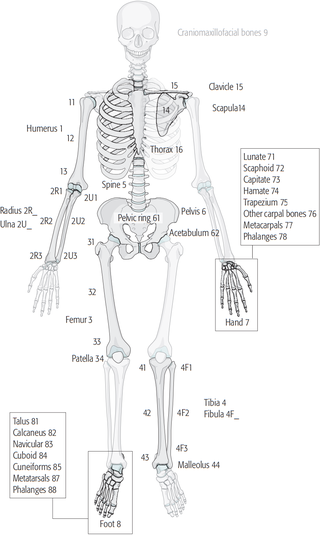
The Müller AO Classification of fractures is a system for classifying bone fractures initially published in 1987 by the AO Foundation as a method of categorizing injuries according to therognosis of the patient's anatomical and functional outcome. "AO" is an initialism for the German "Arbeitsgemeinschaft für Osteosynthesefragen", the predecessor of the AO Foundation.
Femoral head fractures are very rare fractures of the upper end of the thigh bone (femur). They are a very rare kind of hip fracture that may be the result of a fall like most hip fractures but are more commonly caused by more violent incidents such as traffic accidents They are categorized according to the Pipkin classification based on the following bone fracture patterns:

Egan Arley Bernal Gómez is a Colombian professional cyclist who rides for UCI WorldTeam Ineos Grenadiers. In 2019 he won the Tour de France, becoming the first Latin American rider to do so, and the youngest winner since 1909. At the 2021 Giro d'Italia, Bernal took his second Grand Tour win.

A proximal humerus fracture is a break of the upper part of the bone of the arm (humerus). Symptoms include pain, swelling, and a decreased ability to move the shoulder. Complications may include axillary nerve or axillary artery injury.
Nissen-Lie classification is a system of categorizing Colles' fractures. In the Nissen-Lie classification system there are seven types of fractures. The classification system was first published in 1939.

In medicine a Busch fracture is a type of fracture of the base of the distal phalanx of the fingers, produced by the removal of the bone insertion (avulsion) of the extensor tendon. Without the appropriate treatment, the finger becomes a hammer finger. It would correspond to the group B of the Albertoni classification. It is very common in motorcycle riders and soccer joggers, caused by hyperflexion when the tendon is exercising its maximum tension.

Corbin Strong is a New Zealand road and track cyclist, who currently rides for UCI WorldTeam Israel–Premier Tech. He won the points race and finished second in the team pursuit at the 2020 UCI Track Cycling World Championships.